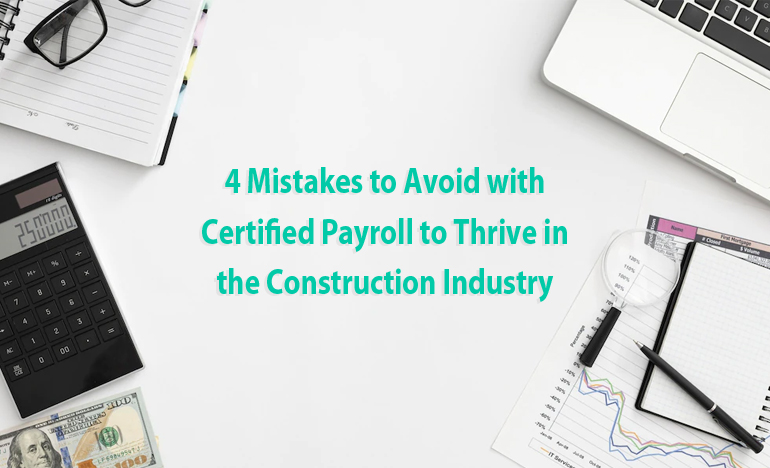4 Mistakes to Avoid with Certified Payroll to Thrive in the Construction Industry

The construction industry has a unique landscape. An extensive onsite and office workforce and a complex compensation structure push construction companies to adopt a solid payroll structure.
However, the ground reality is completely different. As we already know, the construction industry is the least digitized sector, and yet, several construction companies are still using outdated practices for managing payroll.
For filing certified payroll with the U.S. Department of Labor, you need to avoid even minor mistakes to prevent adverse consequences. These consequences can range from costing your company huge losses to breaking your chances of acquiring federal construction contracts.
At its most alarming, filing false certified payroll documents could lead to federal prosecution and detention.
If you're thinking about what some of the most common errors are so you can avoid them, keep reading.
1. Unclear about the requirements for certified payroll reports
The construction industry is renowned for being the most penalty payer when filing certified payroll documents. Therefore, construction business owners need to look for safe ways to stay consistent in the market and compliant with federal laws.
If you employ contractors to complete a federal construction contract, you are more likely to be instructed to submit a weekly WH-347 form. You may have to submit additional payroll reporting depending on your state's laws and regulations.
According to the Davis-Bacon Act, construction companies are to pay no less than the overall wage, including fringe benefits, as the Department of Labor decided. The contractor's obligation to pay fringe benefits can be managed either by paying the fringe benefits to bonafide benefit programs, funds, or programs or by making payments to the covered workers in cash instead of fringe benefits.
Resolution
As a contractor, you need to know about certified payroll reporting in and out to eliminate difficulties and confusion. It's essential to handle the situation by communicating with the U.S. Department of Labor or hiring a payroll specialist who knows about working with certified payroll and what is required.
If you still find it expensive and time-consuming, all you need is an integrated platform that can get the work done for you.
2. Assuming the certified payroll process is equal in all the states
The Davis-Bacon Act that controls certified payroll may be a federal law, but each state in the US has its own unique policies and governing principles. If your employees span numerous states, you also need to know how requirements vary from state to state.
Some states have prevailing wage laws that have different needs. Here are a few discrepancies:
-
A few states are charged a higher amount than others.
-
A few states have lower thresholds than the federal government.
-
Some states, like California, need contractors to be documented with the state.
Resolution
To stay compliant, you need to keep yourself updated with the existing rules and regulations set by the state. Using software like ProjectPro for your construction payroll not only keeps you up-to-date on laws governing certified payroll but also ensures accuracy.
If your experience is restricted, you may also prefer outsourcing the work to a third party with precise expertise in compliance with the Davis-Bacon and Related Acts.
3. Relying too much on software
We understand that a software solution is an excellent choice for contractors. The platform can simplify your payroll process by automating repetitive tasks if the platform is properly integrated. You can save time and devote it to other core activities within the company. Good payroll software can be a true lifesaver, regardless of the size of your construction business.
However, the software cannot reimburse for human error at the end of the day. And if the person liable for the software doesn't know anything about certified payroll, expect blunders.
Also, beware of being too reliant on open source software or something that appears to be extremely cheaper than the others. These generally lack the support required to keep you out of danger.
Resolution
Always keep in mind that software is a tool, and tools are only as good as the individual using them. Even top software needs someone knowledgeable in certified payroll to operate correctly and ensure you comply.
4. Big blunders on your WH-347 form
Filling out the WH-347 form can be confusing because of several ways you can mess up the form. Ensure that you have a highly detail-oriented employee taking charge of this task to prevent some of the typical mistakes made when filling it out, such as:
-
Using a reporting system that is not obliging with Form WH-347. A compliant reporting system will have all the required information, such as the last day of the payroll period, the name and address of the contractor, overtime accrued, if any, the pay rate, and the pay period's dates and days.
-
Numbering payrolls is out of order. It is essential that a sequential numbering system is used to keep a good track. This system is based on how many weeks laborers worked.
-
Do not add the project number. Data is hard to track without the contract project number. This data from certified payroll is critical to ensure compliance.
Resolution
Ensure that the person in charge of filling out your WH-347 is experienced in the job and has a hawk's eye for details. Also, recheck the form thrice before submitting it to ensure it's complete and correct.
Bottom Line
We are your one-stop solution if you want a complete payroll solution. Our robust platform has the capabilities you're looking for, including certified payroll that works with federal contracts.
ProjectPro can assist you in staying compliant with our up-to-date knowledge of every aspect of state and federal laws that govern certified payroll. Schedule a demo now.




.jpg)


